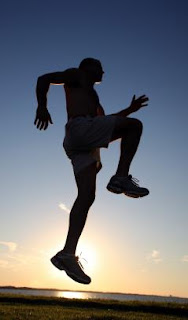The muscle is an amazing creation. It is a marvel of of nature, physics and engineering, and even more amazing is its ability to adapt.
In our context, training or exercise acts as the Stimuli which elicits a response both biochemically and hormonally, that in turn allows us to perform at a higher level of intensity, or in the case of the muscle, force generation.
In order for this to occur there is either an increase in the Cross Sectional Area of the muscle (Hypertrophy), or a Neural adaptation (where more motor units become activated).
Different types and modes of elicit these different adaptions.
A mode of training that has been receiving a lot of attention lately is known as Plyometric training, and contrary to popular to belief has been around for many decades (first developed and used by Eastern Bloc countries).
It works on the principle that the muscle is similar in many ways to an elastic band.
When the muscle is stretched, Potential energy is created, and momentarily stored in the muscle.
If it is not immediately used after storage, it is lost to the environment.
Let us use the runner as an example.
When the foot strikes (Support phase) the the ground, the knee bends slightly, and the thigh muscles are stretched, helping to decelerate the body.
This lengthening of the Quad muscles of the thigh, while under load from the body, is known as Eccentric loading.
This is where the muscle generates and stores Potential energy for use. This energy can either be used in the Elastic recoil of the muscle, or become lost as it dissipates into the ground.
If we are able to move from the Support Phase into the into the Drive Phase quickly enough (known as Amortization rate), we can take advantage of this stored energy, and consequently generate force with a reduced requirement of energy from nutrients.
This however does not happen on its own, and requires a training stimuli that is very effective at increasing performance, but can be just as effective at injuring you and resulting in overtraining.
Plyometric Training has become one of the fitness "Buzz words", and often it is presented to individuals as a great way to get in shape quickly, thanks to the high intensity nature of the movements, and the high level of stress it places on the body.
Plyometrics is an ADVANCED mode of exercise, not for mass consumption, and definitately not for all levels of exerciser.
It is high INTENSITY, high IMPACT and high STRESS on the body and all of its anatomical and physiological systems.!
Here are a few guidelines for you to consider before considering adding Plyos to your program:
- Have you followed a Resistance Training for at least one full cycle of training (through all the phase of training)?
- Do you have any physical limiting factors that might be negatively impacted by this type of training (bad knees, bad heart, asthma etc)?
- What is your Training Age (experience)? You should have been invovled in the activity / sport for at least 2 years.
- Reserach has shown that athletes as young as 13 years of age can get benefit from Plyometric training.
- What are the requirements of your sport? A 10km runner has different conditioning requirements when compared to 42.2km runner.
- Do you have the correct training equipement and facilities?
Obviously a Novice participant to a Plyomtric Program would work on the Low Level Plyos, an Elite level athlete would work on the High and the Shock categories.
What are the benfefits of including some Plyometrics into my program?
Primarily, it is going to assist you increase your bodies abilities to increase explosive power, which translates into improved athletic performance.
For a distance runner, it will allow you to realize the following performance improvements.
- More resilience while running downhill : Downhills require an enormous amount Eccentric Loading and the consequence is muscle fatigue (Eccentric work burns energy X1.5 faster than Concentric work) the muscles quickly become fatigued and performance is negatively impacted.
- More Power running up hill: Most runners slow down and drag themselves up hills. Instead of merely getting up hills, why not maintain your splits, in fact, even make up time?
- Run more economically on flats: The ability to use the Stored Elastic Potential energy will reduce your overall expenditure of stored energy, make you a more economical runner overall.
Here are a few basic, low level plyometric exercises you can incorporate nto your Routine.
Repeat the exercsies as a circuit, make sure you are thoroughly warmed up, and for starters, repeat each movement 10 times (twice).
- Traditonal skipping is a great warm up, and type of Plyometric training, so do this for a couple of weeks before getting into the plyos. It will give you a basic foundation.
- Bounding
- High knees, running on the spot.
- Pogo jumping on the spot (make sure you really push off out of the ankles).
- Squat Jumps (making sure the knees bend on landing)
- Rocket jumps
- Star jumps
By the way, that stiffness you feel after training, called DOMS (delayed Onset Muscle Soreness) has been shown to be the result of the Eccentric Phase of muscle loading (Lowering a weight slowly, running down hills).











